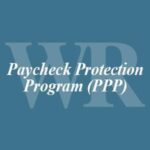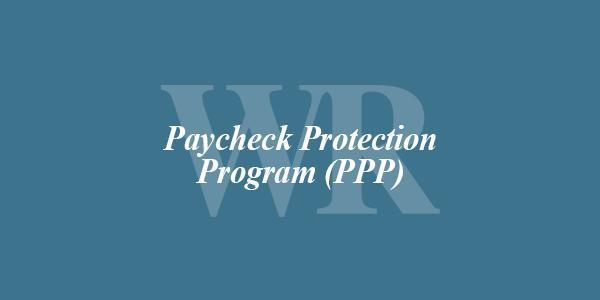
PPP Update- Changes May Be Coming- Don’t Act Too Quickly
June 3, 2020
PPPFA Signed and No More “Forgiveness Cliff”
June 25, 2020Senate Passes Paycheck Protection Program Flexibility Act; What Are the Changes?

As we suggested in our eblast on Monday, it appears changes to the Paycheck Protection Program (PPP) will be made. The House bill titled “Paycheck Protection Program Flexibility Act of 2020” (PPFA) passed the Senate on Wednesday and now heads to the President’s desk to be signed into law. Barring any unforeseen issues, the President will likely sign this bill into law.
In this email we will review the changes this bill makes to the PPP and add some commentary. Keep in mind that the SBA and US Department of Treasury will still need to issue guidance to clarify details and answer questions not addressed in the Act. Another perspective on the changes and outstanding questions can be found in the Forbes Article, Congress Agrees On Favorable Changes To Paycheck Protection Loans: What Does It Mean For Borrowers?.
Changes Made to PPP Through the PPP Flexibility Act of 2020
1. Loan Maturity
The loan maturity for new PPP loans will be 5 years. If you have an existing PPP loan the term is not automatically changed from 2 years however, the Act allows for banks and borrowers to mutually agree to modify the maturity terms of a current loan.
Comments: If you have a PPP loan already and believe you will not be able to achieve full forgiveness and would like a longer term than 2 years to repay the loan balance, you will need to work with your bank to get the term changed to 5 years.
2. “Covered Period” for Forgiveness Changed to 24 Weeks From Origination Date or December 31, 2020
Borrowers now have a forgiveness period of 24 weeks instead of only 8 weeks to use the funds and receive forgiveness. If borrowers prefer to keep their current 8 week covered period, they can elect to do so. The covered period still begins the date the borrower receives the funds and ends the earlier of 24 weeks after that date or on December 31, 2020.
Comments: This change provides borrowers more time to spend their PPP dollars and still receive forgiveness. What needs to be clarified is if borrowers will need to maintain their FTE levels and salary/wage levels for the full 24 weeks in order to still receive 100% forgiveness. The current language suggests the forgiveness reduction tests would apply to the full 24-week period.
3. Changes 75/25 Costs Split to 60/40 But…
The Act changes the requirement that at least 75% of the forgiveness amount must be used for payroll costs to at least 60% of the loan amount must be used for payroll costs or there will be no forgiveness.
Comments: This is a welcome change for many small companies that were being limited by the 75/25 requirement but this does establish a “forgiveness cliff.” Borrowers must make sure they spend at least 60% of the loan on payroll costs or none of the loan will be forgiven.
4. Extends Safe Harbor to December 31, 2020 and Creates New FTE Reduction Exemptions
For the borrowers who qualify for the Safe Harbor, the date by which to get FTEs and salary/wages back to the February 15th levels is now December 31, 2020.
Additionally, there are FTE Exemptions whereby a borrower will not receive a reduction in forgiveness due to reduced FTEs if they are able to document:
(1) they cannot hire back the same employees or a “similarly qualified” replacement by Dec. 31, 2020
or
(2) they cannot “return to the same level of business activity” as they had on Feb. 15, 2020 due to compliance with HHS, CDC or OSHA requirements or guidance issue from March 1, 2020 through Dec. 31, 2020 “related to the maintenance of standards for sanitation, social distancing, or any other worker or customer safety requirement related to COVID-19”
Comments: We will wait for SBA guidance on what documentation would be required to meet this standard.
5. Payroll Tax Deferral Now Available For All
In early April we put out a post discussing the payroll tax deferral that was created under the CARES Act. This tax deferral was available to PPP borrowers only until they received notification of their PPP loan forgiveness. The PPFA removes this restriction so PPP borrowers are able to take advantage of the tax deferral through December 31, 2020 regardless of receiving PPP forgiveness.
Comments: This change may cause many of our clients to now pursue this tax deferral. This is a deferral of the deposit and payment of employer’s share of social security taxes (6.2% on employee wages). If you have not yet pursued this because you received the PPP loan but are now more interested, contact your WR Partner or your relationship manager.
6. Deferral on Principle and Interest Payments on PPP Loans Are Extended
Originally the first payment on PPP loans were deferred 6 months from loan origination. The PPFA extends this deferral so the first payments are not due until the forgiveness amount is remitted to the lender by the SBA, or 10 months after the expiration of the forgiveness period (24 weeks) if a borrower fails to apply for forgiveness.
Comments: While borrowers and lenders continue to try and figure all of this out, and Congress and SBA/Treasury continue to make rules for the program, borrowers can get some peace of mind knowing the first payments for these loans are a good way off. Also getting an answer on forgiveness amounts before having to make any loan payments will hopefully result in most borrowers never having to make any payments on these loans to the banks. With the extended forgiveness period, our hope is that most borrowers will be able to spend all of the dollars in the right way and achieve 100% forgiveness.
Our team will continue to monitor all changes and updates related to PPP and will do our best to keep you apprised. As always, we are here to help and support you.
If you need assistance with your loan tracking or you would like to discuss your situation relative to PPP loan forgiveness, we are here to help. Reach out to your WR Partner or your relationship manager. You can also email our COVID-19 task force for assistance: COVID19TASKFORCE@websterrogers.com.


